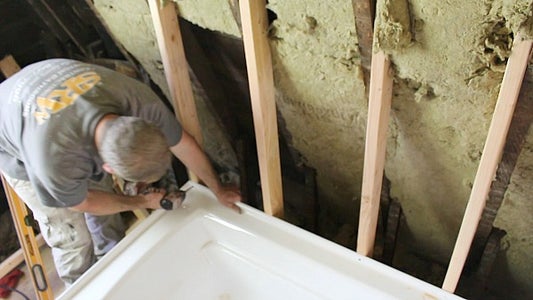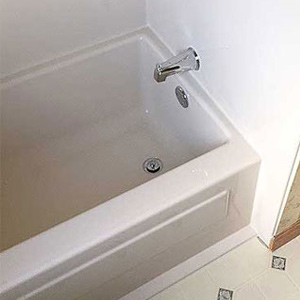We have found this post involving How to Install a Bathtub Yourself directly below on the web and decided it made good sense to discuss it with you here.

Setting up a bath tub isn't exactly brain surgery, however it does need strong plumbing, carpentry, as well as in some cases, tiling abilities. Changing an old bath tub with a brand-new one is additionally a moderately difficult project. If the old tub is easily available, the job can move rapidly; if you need to open up a wall surface to get rid of the old bathtub and also place the brand-new bath tub, the job is a lot harder. In either instance, the task is within a residence handyman's abilities, although you will certainly need a helper to leave the old bathtub and embeded in the brand-new one. Make sure you have qualified yourself for the job as well as are comfortable trying it. Instead of working with a service provider to take control of a halfway-completed task, it is far better to consider utilizing one prior to you start. Opportunities are you may need a professional plumber to make tube connections.
This article will help you install a new bathtub in your bathroom if you have already bought a new tub as well as do not require to transform the setup of your previous water supply pipes.
Your tools and material checklist ought to make up the following:
Planning for the Installment
Firstly, the sustaining structure provided with the bathroom must be fitted (if called for) according to the supplier's directions. Next off, fit the faucets or mixer to the tub. When fitting the tap block, it is essential to make sure that if the tap features a plastic washer, it is fitted between the bathroom as well as the taps. On a plastic bath, it is additionally reasonable to fit a supporting plate under the taps device to stop stress on the tub.
Fit the adaptable faucet ports to the bottom of the two faucets utilizing 2 nuts and olives (sometimes provided with the tub). Fit the plug-hole outlet by smearing mastic filler round the sink outlet hole, and after that pass the outlet via the hole in the bath. Use the nut provided by the maker to fit the plug-hole. Analyze the plug-hole electrical outlet for an inlet on the side for the overflow pipeline.
Next, fit completion of the versatile overflow pipe to the overflow electrical outlet. After that, screw the pipeline to the overflow face which must be fitted inside the bath. See to it you utilize all of the provided washers.
Attach the trap to the bottom of the waste electrical outlet on the tub by winding the thread of the waste electrical outlet with silicone mastic or PTFE tape, and screw on the catch to the outlet. Attach the bottom of the overflow tube in a similar manner.The bathroom should currently prepare to be fitted in its last setting.
Removing Old Touches
If you need to change old taps with brand-new ones as a part of your setup, then the first thing you must do is disconnect the water system. After doing so, turn on the faucets to drain any type of water remaining in the system. The procedure of getting rid of the existing taps can be fairly troublesome as a result of the restricted accessibility that is frequently the instance.
Use a container wrench (crowsfoot spanner) or a tap tool to reverse the nut that connects the supply pipelines to the faucets. Have a towel prepared for the continuing to be water that will originate from the pipelines. Once the supply pipelines have actually been eliminated, make use of the same tool to loosen up the nut that holds the taps onto the bath/basin. You will require to stop the single faucets from turning during this procedure. As soon as the taps have actually been gotten rid of, the holes in the bath/basin will need to be cleaned up of any kind of old sealing compound.
Prior to moving on to fit the new faucets, contrast the pipe connections on the old faucets to the brand-new taps. If the old taps are longer than the new faucets, then a shank adapter is required for the new taps to fit.
Setting up the Bath tub
Utilizing both wood boards under its feet, place the bathtub in the needed placement. The wood boards are useful in uniformly spreading out the weight of the bathtub over the area of the boards as opposed to concentrating all the weight onto 4 tiny points.
The next objective is to guarantee that the tub is leveled all round. This can be attained by checking the spirit level and also adjusting the feet on the tub up until the level reads level.
To set up faucets, fit the bottom of the furthest versatile faucet connector to the suitable supply pipe by making a compression sign up with; after that do the same for the other tap.
Turn on the water system and also examine all joints and also brand-new pipework for leakages and also tighten them if necessary. Fill the bathtub and also check the overflow outlet and the normal outlet for leaks.
Finally, repair the bath paneling as described in the producer's instruction manual. Tiling and sealing around the bathtub should wait until the bathtub has actually been made use of at the very least when as this will certainly resolve it right into its final setting.
Fitting New Taps
If the tails of the new faucets are plastic, after that you will certainly require a plastic connector to stop damages to the string. One end of the port fits on the plastic tail of the tap as well as the other end provides a link to the current supply pipelines.
If you require to fit a monobloc, then you will need minimizing couplers, which links the 10mm pipe of the monobloc to the standard 15mm supply pipeline.
Next off, position the tap in the mounting hole in the bath/basin guaranteeing that the washers remain in area in between the tap and the sink. Safeguard the faucet in place with the manufacturer provided backnut. As soon as the faucet is securely in place, the supply pipelines can be linked to the tails of the taps. The faucets can either be attached by using corrugated copper piping or with normal faucet ports. The former kind must be linked to the tap finishes first, tightening just by hand. The supply pipelines can later on be linked to the other end. Tighten up both ends with a spanner after both ends have been attached.
Tiling Around the Tub
In the area where the bathroom satisfies the tile, it is essential to secure the joins with a silicone rubber caulking. This is necessary as the installation can move sufficient to break a rigid seal, creating the water to penetrate the wall surface between the bathroom and the tiling, bring about problems with dampness and possible leakages to the ceiling below.
You can select from a variety of coloured sealants to assimilate your fixtures and also fittings. They are marketed in tubes and cartridges, and also can sealing voids up to a size of 3mm (1/8 inch). If you have a larger void to fill, you can load it with twists of drenched newspaper or soft rope. Keep in mind to always fill up the bath tub with water before securing, to allow for the activity experienced when the tub remains in usage. The sealant can fracture relatively very early if you do not consider this activity before securing.
Conversely, ceramic coving or quadrant ceramic tiles can be made use of to edge the bath or shower tray. Plastic strips of coving, which are easy to use as well as reduce to size, are additionally easily readily available on the market. It is a good idea to fit the ceramic tiles making use of water-resistant or water resistant glue and cement.
Bathtub Installation
How Important Is A Bathtub To Your Home?
High-quality baths, showers, and other bathroom updates are necessary when considering a smart investment in your home. It’s a room that you go to every day and one that is constantly being used by guests.The bathroom is one of the top trafficked rooms in a home and also one of the most valuable in terms of home resale.
Install Piping Before Tub
You will be using your existing drain and waste vent system, but pipes required include the hot and cold water supply lines and a pipe leading to a shower head. A mixing valve and shower head are also needed. Air chambers may be required.
Position the Tub
Lower the tub into place so that the continuous flange fits against the wall studs and rests on 1’x4' or 2’x4' supports. Anchor the tub to the enclosure with nails or screws inserted through the flanges into the studs.
NOTE: Remember, bathtubs and shower stalls may require support framing. A bathtub filled with water is extremely heavy, so check building codes and framing support before installing the tub.
Assemble Drain Connections
Assemble the bathtub drain connections by connecting the tub overflow with the tub drain above the trap, not beyond it. The trap will have a compression fitting that screws over the arm of the overflow assembly.
Place a Pipe For the Shower Head
First, locate a brass female threaded winged fitting and attach it to a framing support via a screw or a nail. Then run a pipe up the wall for the shower head. Sweat or solder the other side of the brass fitting to the top of the pipe.
Attaching Hot and Cold Water Lines
Attach your water lines for both hot and cold by sweating these directly into the hot and cold ports of the mixing valve. The mixing valve will be how water enters the tub’s system, not by the pipes themselves.
Install the Spout
Extend a piece of 1/2 inch pipe, or whichever length is specified in the manufacturer’s instructions, for the tub spout. Sweat on a male threaded fitting at the end of the pipe or use a brass nipple of the proper length and a 1/2 inch cap.
NOTE: At this point you should have your rough-in plumbing work inspected before proceeding further.
Check For Leaks
Restore the water pressure and check the drain connection and the supply pipes for any sign of leaking.
estore the Bathroom Wall
Replace the wall with moisture-resistant drywall as a base for your wall covering. Seal the joints between the wall and your new tub with silicone caulk as protection against water seepage.
https://www.berkeys.com/2016/12/02/bathtub-installation-dallas/

I stumbled upon that content about Tools You Need to Install a New Bathtub while doing a lookup on the web. Appreciated our article? Please share it. Help someone else find it. We love reading our article about How to Install a Bathtub: Install an Acrylic Tub and Tub Surround.
Visit Our Website